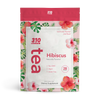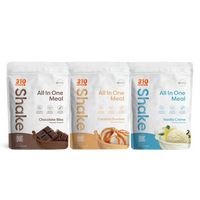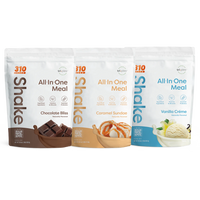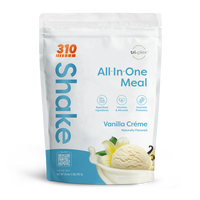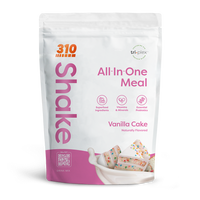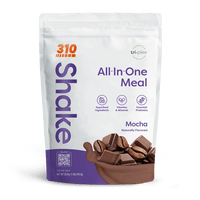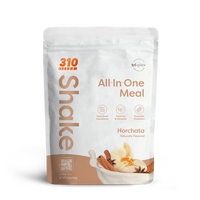If you’re getting ready to hop on the keto train, you may be wondering what all the buzz is between the “dirty” and “clean” versions. The simple answer is that both options offer the flexibility to choose a version of the keto diet that best suits your lifestyle. While each option has the same goal of moving your body into a state of ketosis, the approaches to food quality, nutrient density, and overall health priorities couldn't be more different. In this article, we’ll review the pros and cons of each approach to help you determine the most optimal path for you. But, before we dive in, let's take a closer look at what the ketogenic diet is and how the dirty and clean versions emerged from it.
What Is the Keto Diet?
The ketogenic, or keto, diet is a high-fat, low-carbohydrate dietary approach designed to shift your body's metabolism into a state called ketosis. In ketosis, the body relies primarily on fat for energy instead of carbohydrates. This transition occurs when you drastically reduce your carbohydrate intake and your liver begins to break down fat into molecules called ketones, which are then used for energy. The primary goal of the keto diet is to get your body to maintain a state of ketosis, which can have various health benefits, including weight loss and improved blood sugar. Over the years, as its popularity increased, people began to customize the keto diet to suit their lifestyles, tastes, and dietary priorities.
Clean Keto vs. Dirty Keto: What’s the Difference?
While the original keto diet placed a strong emphasis on a high-fat, low-carb, and moderate-protein diet, the “clean” and “dirty” versions of keto offer the flexibility to customize the program to best suit your lifestyle.
With a heavier focus on macronutrient ratios and less on food quality, “dirty” keto is known as the less-restrictive version of the keto diet. As long as the foods meet the macronutrient requirements, you can eat processed and artificially sweetened foods, such as fast food burgers without buns, sugar-free snacks, and processed meats.
Conversely, “clean” keto prioritizes adding more whole, unprocessed, naturally nutritious foods to your diet. The same macronutrient ratios are followed with clean keto, but the focus is on full, unprocessed, nutrient-dense meals, and an emphasis on high-quality lipids, proteins, and carbohydrates. If you opt for the clean version of keto, you’ll want to focus on high-quality fats like avocados, nuts, and grass-fed butter, along with lean proteins from sources like organic meats, wild-caught fish, and free-range poultry. Vegetables are also a significant component, with an emphasis on non-starchy, fiber-rich options.
Dirty Keto Food List

Since dirty keto focuses primarily on macronutrient ratios, emphasizing high fat intake, moderate protein consumption, and very low carbohydrate intake, you don’t have to be so concerned about the quality of foods you choose. Foods commonly included in a dirty keto diet include:
Processed Meats: This can include bacon, sausages, and other processed meats that are high in fat and low in carbs.
Fast Food Burgers without Buns: Dirty keto enthusiasts often opt for fast food burgers without the bun to reduce carbohydrate intake while still getting a high-fat content.
Artificially Sweetened Foods: Sugar-free snacks, diet sodas, and other artificially sweetened products are often consumed on a dirty keto diet.
Low-Carb Packaged Foods: This may include packaged snacks and meals specifically designed for low-carb or ketogenic diets.
Processed Cheese: Processed cheese products, like cheese slices and cheese spreads, are convenient sources of fat in a dirty keto diet.
Cooking Oils: Oils like vegetable oil and canola oil are sometimes used for cooking and frying, even though they may not be optimal fat sources.
Low-Carb Condiments: Condiments such as mayonnaise and sugar-free ketchup are commonly used in dirty keto recipes.
Clean Keto Food List

If you find that clean keto is a better option for you, you’ll want to focus on whole, unprocessed, and nutrient-dense foods that provide a wide range of vitamins, minerals, and other beneficial compounds (while adhering to the same macronutrient ratios as dirty keto). Foods included in a clean keto diet usually consist of:
Avocados: Rich in healthy fats, avocados are a staple in clean keto due to their nutrient density.
Olive Oil: Extra virgin olive oil is a source of monounsaturated fats and antioxidants. [1]
Nuts and Seeds: Almonds, walnuts, chia seeds, and flaxseeds are excellent sources of fats and fiber.
Organic Meats: Grass-fed beef, free-range poultry, and organic meats are preferred choices for clean protein.
Wild-Caught Fish: Fatty fish like salmon, mackerel, and sardines provide omega-3 fatty acids and protein.
Grass-Fed Butter: High-quality butter from grass-fed cows is a source of healthy fats and fat-soluble vitamins.
Non-Starchy Vegetables: Leafy greens, broccoli, cauliflower, and other low-carb vegetables are rich in vitamins and fiber.
Berries (in Moderation): Berries like blueberries and strawberries can be included in clean keto in limited quantities due to their lower carbohydrate content compared to other fruits.
Nutritional Differences Between Dirty and Clean Keto
The quality of food sources and the general makeup of nutrients are the main areas where dirty keto and clean keto differ nutritionally. Let’s take a look as some of the differences:
Dirty Keto
The dirty keto diet primarily focuses on macronutrient ratios, emphasizing high fat and minimal carbohydrates, and often neglecting the quality of food sources. While it may lead to short-term weight loss, this version tends to lack essential nutrients, fiber, and promotes unhealthy food choices. It's crucial to prioritize whole, nutrient-dense foods for long-term health.
Emphasis on Macronutrients: The dirty keto approach places a strong emphasis on the ratios of macronutrients, with the main goal being to maintain ketosis by consuming a high-fat, moderate-protein, and low-carb diet.
Reduced Nutrient Density: A reduced overall nutrient density may arise from the processed and artificially sweetened foods that are a common part of the dirty keto diet. These foods might be deficient in important vitamins, minerals, and other healthy ingredients.
Greater Levels of Saturated and Trans Fats: Processed meats and inferior cooking oils are two examples of foods high in saturated and trans fats that are consumed with the dirty keto path. When these fats are ingested in excess, they may have detrimental effects on health.
Limited Fiber: The diet may be deficient in items high in fiber, such as whole grains and non-starchy vegetables, which could cause digestive problems and worsen gut health.
Potential Health Risks: Over time, eating fake and processed meals can raise your chance of developing heart disease, inflammation, and other health issues. Deficits in certain nutrients can also lead to problems.
Clean Keto
This version of the keto diet typically includes high-quality fats, lean proteins, and non-starchy vegetables. Clean keto can provide essential nutrients while promoting ketosis for weight management and improved metabolic health.
Focus on Balanced Macronutrients: Clean keto follows the same dietary guidelines as dirty keto, but it prioritizes whole foods above everything else. It promotes eating meals that are complete, unprocessed, and high in nutrients.
Greater Nutrient Density: The incorporation of whole foods including veggies, nuts, seeds, and premium meats gives clean keto a higher nutrient density. A variety of vitamins, minerals, and antioxidants can be found in these foods.
Better Fats: Clean keto encourages the use of better fats, which are linked to better heart health and offer a better balance of fatty acids. Examples of these fats are avocados, olive oil, and grass-fed butter.
Rich in Fiber: A varied gut microbiota and improved digestive health are supported by the use of non-starchy veggies in the clean keto diet.
Long-Term Health Benefits: Clean keto's emphasis on high-quality foods may improve long-term health results, such as lowered risk of chronic diseases and inflammation.
|
Aspect |
Dirty Keto |
Clean Keto |
|
Food Quality |
Emphasizes macronutrient ratios over food quality |
Prioritizes whole, nutrient-dense foods |
|
Carbohydrate Sources |
Allows for processed and low-quality options |
Focuses on non-starchy vegetables, lean meats |
|
Artificial Sweeteners |
Often includes artificial sweeteners |
Limited use of artificial sweeteners |
|
Fiber |
May lack fiber-rich foods |
Includes fiber-rich options for gut health |
|
Nutrient Density |
Lower nutrient density due to processed foods |
Higher nutrient density due to whole, nutrient-dense ingredients |
|
Long-Term Health |
Potential concerns about health risks |
May promote better long-term health outcomes |
|
Meal Planning Effort |
Less time-consuming |
May require more effort due to ingredient quality |
|
Expense |
Potentially more budget-friendly |
May be more expensive due to quality ingredients |
Foods to Avoid in Both Diets
Both dirty keto and clean keto diets restrict certain types of foods to achieve and maintain ketosis. Here’s a list of foods to avoid regardless of which version of keto you opt for:
Sugary Foods: Both dirty and clean keto diets require the avoidance of sugary foods, including candy, cakes, cookies, and other desserts, as they are high in carbohydrates and can quickly disrupt ketosis.
Grains: Grains such as wheat, rice, oats, and corn are rich in carbohydrates [2] and should be excluded from both diets as they can raise blood sugar levels.
High-Sugar Fruits: Fruits like bananas, grapes, and tropical fruits are high in natural sugars and should be limited or avoided in both dirty and clean keto diets.
Legumes: Legumes like beans, lentils, and chickpeas are carbohydrate-rich foods and are generally not compatible with either diet due to their significant carb content.
Processed Vegetable Oils: Both diets discourage the use of processed vegetable oils, such as soybean oil, corn oil, and canola oil, which are high in inflammatory omega-6 fatty acids.
High-Carb Vegetables: While non-starchy vegetables are encouraged, high-carb vegetables like potatoes, sweet potatoes, and carrots should be consumed in moderation or avoided.
High-Sugar Condiments: Condiments like regular ketchup, barbecue sauce, and sweet dressings contain added sugars and should be replaced with sugar-free or low-carb alternatives.
Processed and Artificially Sweetened Foods: Both diets discourage processed and artificially sweetened foods, such as sugar-free candies and diet sodas, as they may disrupt blood sugar control and may not align with the goals of these diets.
Alcohol: Alcoholic beverages are often high in carbohydrates and can hinder ketosis. While some low-carb alcoholic options exist, alcohol should be consumed in moderation or avoided, especially in the initial phases of the diet.
Potential Benefits and Drawbacks
There can be potential benefits and drawbacks for you with whichever version of keto you choose. Let's break it down in detail:
Dirty Keto Diet
It's important to weigh benefits and drawbacks when considering the dirty keto diet and to consult with a healthcare professional, registered dietitian, or support group to ensure it aligns with your specific health goals and needs.
Benefits
The dirty keto diet, characterized by its focus on macronutrient ratios rather than food quality, offers the following potential benefits:
Simplicity: Dirty keto can be easier to follow for some individuals due to its flexibility regarding food choices, making it more convenient in certain situations.
Initial Weight Loss: Like other ketogenic diets, dirty keto can lead to initial weight loss due to the body's transition into ketosis, which primarily burns stored fat for energy.
Appetite Control: Dirty keto can help control appetite and reduce cravings, making it easier for some people to stick to their dietary goals.
Drawbacks
The dirty keto diet, which focuses solely on macronutrient ratios without emphasizing food quality, also comes with several drawbacks:
Nutrient Deficiencies: A significant drawback of dirty keto is that it often lacks essential nutrients since it prioritizes macronutrient ratios over food quality. This can lead to potential nutrient deficiencies in the long run.
Health Risks: Consuming processed and artificial foods can have negative health implications, including increased risk of heart disease, inflammation, and other health issues.
Sustainability: Dirty keto may not be a sustainable long-term diet due to its potential health risks and limited nutritional benefits.
Clean Keto Diet
The clean keto diet offers a balanced approach with potential long-term health benefits, but it may require more dedication and financial commitment. It's essential to consider a number of factors when choosing a diet that aligns with your health goals and lifestyle.
Benefits
The clean keto diet emphasizes whole, unprocessed foods and healthy fats, promoting weight loss by inducing ketosis, where the body burns fat for energy and offers several potential benefits:
Nutrient-Dense: Clean keto focuses on whole, nutrient-dense zero carb keto foods, providing a wide array of vitamins, minerals, and antioxidants that support overall health and well-being.
Long-Term Health: The emphasis on food quality in clean keto may lead to better long-term health outcomes, reduced inflammation, and a decreased risk of chronic diseases.
Sustainable: Clean keto is often considered a more sustainable and balanced approach to the ketogenic diet because it promotes healthier eating habits and can be maintained over the long term.
Drawbacks
The clean keto diet, while emphasizing healthy and whole foods, does have the following drawbacks:
Cost: Clean keto may be more expensive than dirty keto due to the emphasis on high-quality, organic, and unprocessed foods.
Time-Consuming: Preparing whole, unprocessed foods can be more time-consuming than relying on packaged and processed options.
Strictness: Clean keto can be challenging for some individuals to adhere to due to its strict focus on food quality, making it less flexible in certain situations.
Choosing Between Clean and Dirty Keto
It’s important to consider a variety of factors before making the decision between clean keto and dirty keto. Maintaining the macronutrient ratios are the hallmark of the ketogenic diet, but the clean version places an emphasis on the quality of the food you eat. So, if you’re concerned about long-term health, nutrient density, and general well-being, this could be a great option for you. Consuming clean keto foods such as avocados, organic meats, and olive oil can provide an abundant supply of vitamins, minerals, and antioxidants. In addition to lowering the risk of chronic diseases, this strategy may also help lessen inflammation, as well. However, quality foods can be more expensive, and meal planning and preparation may take more time and effort.
On the other hand, dirty keto places less emphasis on the quality of food and more emphasis on obtaining the right macronutrient ratios to induce ketosis. With greater flexibility in food choices — including processed and artificially sweetened items — this method can be more practical if you’re looking for a dietary option that fits into your busy lifestyle. However, keep in mind that since the dirty keto option frequently consists of meals that are deficient in vital nutrients, it’s an option that may eventually lead to negative health implications, like an elevated risk of inflammation and heart disease.
When deciding between clean and dirty keto, think about your own objectives and current lifestyle. Clean keto can be a better option if your general health is your top priority, you have the time to make meals, and you are prepared to spend money on premium foods. However, dirty keto might be a better option if you're looking to lose weight quickly or induce ketosis. This is especially true if convenience is a top priority. Remember that there is also potential for a balanced strategy that incorporates aspects of both versions, which not only offers the most flexibility, but also honors your commitment to food quality where/when feasible.
How to Boost Your Ketosis Level
Boosting ketosis while following either a clean keto or dirty keto diet involves certain strategies and practices. Here are some general tips to help you achieve and maintain ketosis:
Strictly Limit Carbohydrates: Ensure that your daily carbohydrate intake is low enough to trigger ketosis. This typically means consuming fewer than 50 grams of net carbs per day, although individual requirements may vary.
Monitor Your Macros: Keep track of your macronutrient intake to maintain the desired fat-to-carbohydrate ratio for ketosis. Use apps or tools to help you stay on track.
Prioritize Healthy Fats: Focus on including healthy fats in your diet, such as avocados, olive oil, coconut oil, and nuts. These fats support ketosis and overall health.
Incorporate Protein Wisely: While protein is important, avoid excessive protein intake, as it can potentially interfere with ketosis. Ensure that protein intake is moderate and fits within your daily macro allowance.
Stay Hydrated: Drink plenty of water to stay hydrated and support metabolic processes. Adequate hydration is essential for ketosis.
Intermittent Fasting: Consider intermittent fasting, which involves cycling between periods of eating and fasting. [3] This can help deplete glycogen stores and promote ketone production.
Choose Nutrient-Dense Foods: Opt for whole, nutrient-dense foods, such as non-starchy vegetables, organic meats, and high-quality fats. These foods provide essential vitamins and minerals while supporting ketosis.
Avoid Processed Foods: Stay away from processed or heavily refined foods, even if they fit within your macros. The emphasis is on food quality.
Include Fiber-Rich Foods: Incorporate low-carb, fiber-rich foods like leafy greens and cruciferous vegetables to maintain digestive health and promote a diverse gut microbiome.
Pick Nutritious Keto Meal Replacement Shakes: In addition to nutrient-dense foods, you might want to choose nutritious keto meal replacement shakes like 310 Nutrition meal replacement shakes. These keto shakes are not only packed with essential nutrients, but are also crafted with TriPlex™ Protein formula, which can enhance your ketosis, support metabolism, and promote lean muscle.
Stay Within Your Macro Allowance: Focus on macronutrient ratios while allowing for more flexibility in food choices. Track your daily intake to ensure you stay within your desired macros.
Avoid High-Carb Traps: Be mindful of hidden carbohydrates in processed foods. Read labels and be aware of ingredients that may contain hidden sugars or carbs.
Limit Artificial Sweeteners: While dirty keto may allow artificial sweeteners, use them sparingly, as some individuals may find that they affect blood sugar and cravings.
Incorporate Exercise: Regular physical activity, such as resistance training and high-intensity interval training (HIIT), can help deplete glycogen stores and enhance ketone production.
FAQs
Can you lose weight on dirty keto?
Yes! It’s definitely possible to lose weight on dirty keto because it shares the same fundamental principle of carbohydrate restriction as clean keto and other ketogenic diets. By limiting carbohydrates, dirty keto can induce ketosis, where the body primarily burns fat for energy, leading to weight loss. However, it's essential to remember that while weight loss may occur, the long-term health implications of a dirty keto diet should be considered because it prioritizes processed and low-quality foods that may lack essential nutrients and have an effect on overall well-being.
How do I get started with a dirty keto diet?
To start a dirty keto diet, set macronutrient targets (high fat, low carb, moderate protein), choose processed keto-friendly foods, track your intake, stay hydrated, be mindful of artificial sweeteners, consider meal planning, and monitor your progress while keeping in mind its potential long-term health implications.
How do I get started on a clean keto diet plan?
To follow a clean keto diet plan, focus on eating whole foods, monitoring macros (high fat, moderate protein, low carb), staying hydrated, and choosing fiber-rich options. Be sure to limit processed foods, plan your meals, and consult a registered dietitian for personalized guidance.
How does the keto diet differ from clean eating?
The main areas where keto and clean eating diverge are in how they handle food quality and macronutrients. In order to achieve ketosis, the ketogenic diet emphasizes macronutrient ratios with a high-fat, low-carb, and moderate-protein focus. In contrast, clean eating places a premium on whole, minimally processed foods and highlights high-quality products for general health. While clean eating encourages a wide variety of nutrient-dense foods without precise macronutrient aims, keto is more carbohydrate-restrictive. Both can aid in weight loss, but they appeal to distinct dietary ideologies: clean eating places more emphasis on general nutrition and well-being, while keto places more emphasis on metabolic improvements.
Summary
To sum up, the decision between clean keto and dirty keto ultimately comes down to your individual nutritional tastes, values, and personal ambitions. While dirty keto is flexible and convenient, it may cause long-term health issues and nutrient shortages since it places more emphasis on macronutrient ratios than food quality. Clean keto, on the other hand, emphasizes full, nutrient-dense foods, which may lower the risk of chronic diseases and enhance general well-being, but could involve more work and costs. A registered dietitian or healthcare professional can offer individualized advice based on your particular circumstances.
Reference
- Silenzi, A., Giovannini, C., Scazzocchio, B., Varì, R., D’Archivio, M., Santangelo, C., & Masella, R. (2020). Extra virgin olive oil polyphenols: Biological properties and antioxidant activity. In Pathology (pp. 225-233). Academic Press.https://doi.org/10.1016/B978-0-12-815972-9.00022-6
- Zhang, G., & Hamaker, B. R. (2021). Whole grain Carbohydrates. Whole Grains and Health, 55-69.https://doi.org/10.1002/9781118939420.ch4
- Patterson, R. E., Laughlin, G. A., Sears, D. D., LaCroix, A. Z., Marinac, C., Gallo, L. C., ... & Villaseñor, A. (2015). Intermittent fasting and human metabolic health. Journal of the Academy of Nutrition and Dietetics, 115(8), 1203. 10.1016/j.jand.2015.02.018


